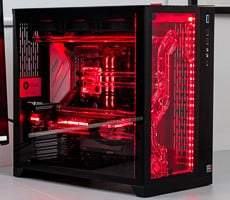MSI GT60 Dominator Pro Gaming Laptop Review
The GT60 Dominator Pro offers more external ports and connectivity options than the Alienware 17, even though it's a cheaper system with a smaller chassis.
There are four USB ports (3x USB 3.0, 1x USB 2.0), two mini-DisplayPort, one full-sized HDMI, and four audio jacks for connecting to a multi-speaker system.
Both DisplayPorts are capable of driving a 4K monitor -- we checked -- and the system adapts flawlessly to the addition of a second display. Plug in a new monitor, and the Intel integrated chip takes over driving the laptop, while the Nvidia GPU handles the external. That makes sense -- most people who plug in a secondary monitor probably do it to game on a bigger screen, though the sheer fidelity and quality of the 3K panel on the Dominator Pro nearly make that a moot point.
The biggest difference between the Dominator Pro and the Alienware 17 is how much easier it is to cart the MSI system between Point A and B. It's lighter (7.7 lbs versus 9.2 lbs) and its smaller chassis make it more manageable. While it's huge and clunky compared to a MacBook Air, the MSI Dominator Pro is a laptop that still squeaks in as "portable." The Alienware 17 is better classified as "Transportable."
The one downside to the Dominator Pro's external design is its reliance on stickers and silkscreens. It's not nearly as bad as the Asus G50V from several years ago, which set a world record for most dubious application of adhesive, but it's bad enough.
First, the Asus G50V.

And the MSI Dominator Pro.

Rampant product branding make this $2400 laptop feel like a cheaper also-ran. There's a reason why Apple doesn't include any and the vast majority of high-end PC manufacturers, including Alienware, opt for very few -- it makes the system feel cheap. And MSI knows it makes the system look cheap, because if you look at the company's stock photography, all of the system images look like this:

Unfortunately, the numerous brand efforts and value-added "inclusions" are more than just skin deep.
Value "Added" Software:
The Dominator Pro's software stack is a perfect example of why Mac laptops and other bloatware-free premium machines are so popular with high-end customers. Immediately upon booting up, a large pop-up appears in the lower-right hand corner of the screen. MSI wants me to register my laptop. There's no way to close the pop-up except to click on Register -- and if you quit the browser without registering, the pop-up reappears. The only way to quit the program is to kill it in Task Manager.
There are multiple Norton Security applications on this system by default. All of them fling pop-ups reminding you to register / activate / pay Norton a significant amount of money. Norton Security, the primary application, pulls all the usual tricks -- it puts the red X for "Exit" in non-standard locations, switches the location of "Yes" and "No" responses when attempting to uninstall, and requires multiple "Are you REALLY sure?!" statements before it'll let you remove it.

This. Is. Not. Boutique.
I get it. PC margins are terrible. Manufacturers are badly squeezed. High-end gaming notebooks are one of the only growth areas, which means there's a great deal of pressure to squeeze every last bit of revenue out of these systems. But therein lies the problem -- the GTX60 Dominator Pro isn't a $500 system. The first rule of a premium product is to make the buyer feel like a premium customer. A $2400 laptop with its stickers, its silkscreened branding, and its 60-day free trial of Norton Software detracts from the user experience.








